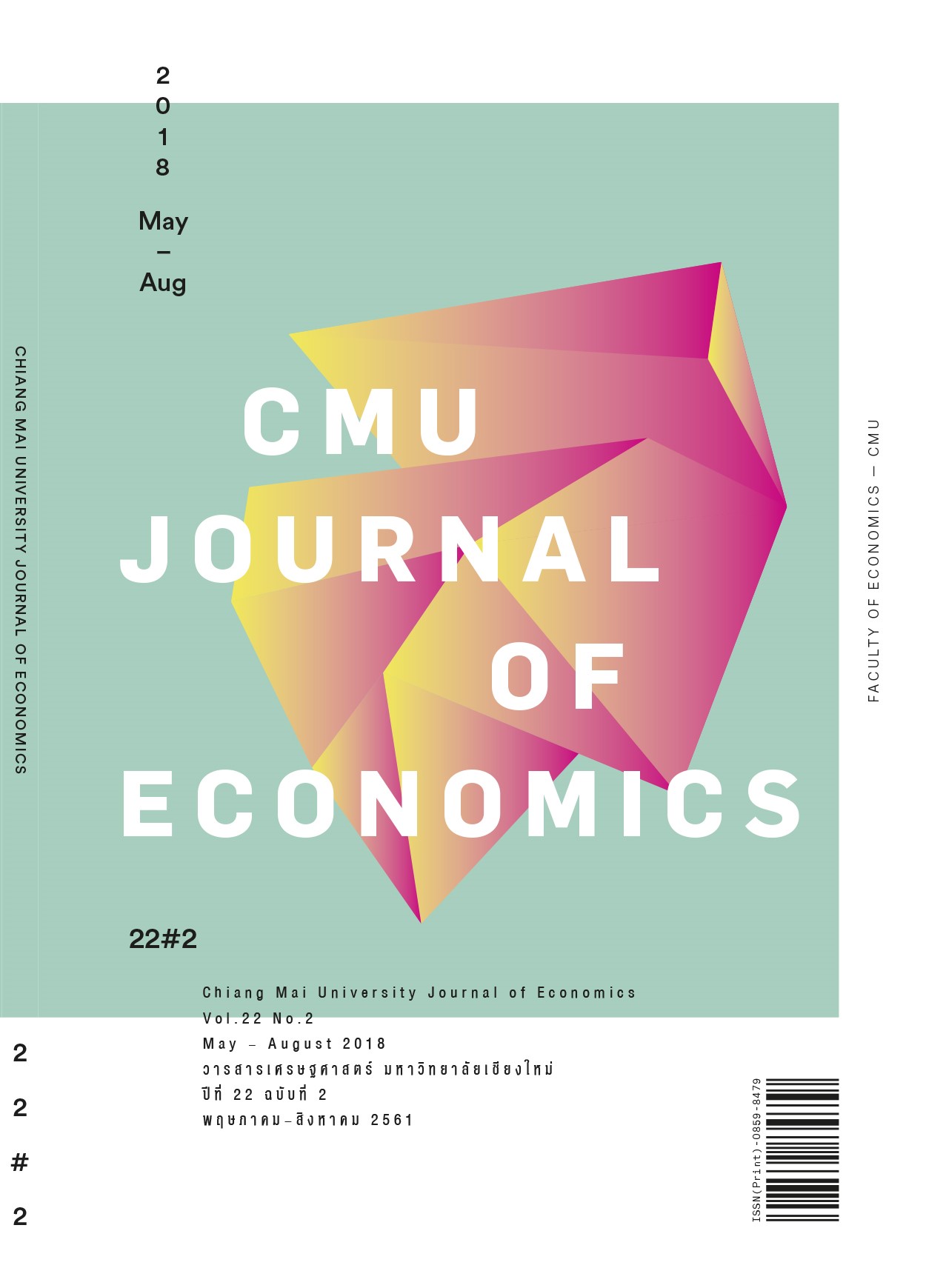Green Efficiency Analysis of Longan Supply Chains: A Two-Stage DEA Approach
Keywords:
Longan supply chains, green supply chain management, green efficiency, two-stage DEAAbstract
The environmental and social concerns in managing agribusiness are increasing in Thailand. Green supply chain management (GSCM) is becoming more significant tool to improve performance of the process and products according to the environmentally friendly regulations. However, there is a question associating with how to evaluate the green performance of supply chain. This paper applies two-stage DEA model for measuring the network performance of the growers and processors in longan supply chains. The major result represents that the high level of economic efficiency of longan supply chains does not ensure the high score of green performance efficiency. The finding of this research leads to the policy making of the government agencies in promoting the green supply chain of longan to create value added of products and enhance competitiveness, as well as encourage the environmental awareness of the growers and processors.
References
Andiç, E., Yurt, O., and Baltacioglu, T. (2012). Green supply chains: Efforts and potential applications for the Turkish market. Resources, Conservation and Recycling, 58, 50-68.
Azevedo, S.G., Carvalho, H., and Machado, V.C. (2011). The influence of green practices on supply chain performance: A case study approach. Transportation Research Part E, 47, 850-871.
Barrett, C.B., Bellemare, M.F., and Hou, J.Y. (2010). Reconsidering conventional explanations of the inverse productivity-size relationship. World Development, 38(1), 88-97.
Beamon, B.M. (1999). Measuring supply chain performance. International Journal of Operations and Production Management, 19(3), 275-292.
Chan, R.Y.K., He, H., Chan, H.K., and Wang, W.Y.C. (2012). Environmental orientation and corporate performance: The mediation mechanism of green supply chain management and moderating effect of competitive intensity. Industrial Marketing Management, 41, 621-630.
Chaowarat, W., and Shi, J. (2013). Efficiency measurement of supply chain in the export frozen vegetable industry: A network DEA approach. International Journal of Materials, Mechanics and Manufacturing, 1(1), 88-91.
Charnes, A., Cooper, W.W., and Rhodes, E. (1978). Measuring the efficiency of decision making units. European Journal of Operational Research, 2, 429-444.
Chen, Y, Liang, L., and Zhu, J. (2009). Equivalence in two-stage DEA approaches. European Journal of Operational Research, 193, 600-604.
Chen, C.C., Shih, H.S., Shyur, H.J., and Wu, K.S. (2012). A business strategy selection of green supply chain management via an analytic network process. Computers and Mathematics with Applications, 64, 2544-2557.
Council on Environmental Quality. (1996). The 1996 Annual Report of the Council on Environmental Quality. [Online]. Retrieve: https://clintonwhitehouse4.archives.gov/CEQ/ reports/1996/toc.html.
Dües, C.M., Tan, K.H., and Lim, M. (2013). Green as the new lean: How to use lean practices as a catalyst to greening your supply chain. Journal of Cleaner Production, 40, 93-100.
Eltayeb, T.K., Zailani, S., and Ramayah, T. (2011). Green supply chain initiatives among certified companies in Malaysia and environmental sustainability: Investigating the outcomes. Resources, Conservation and Recycling, 55(5), 495-506.
FAO. (2014). The State of Food and Agriculture 2014: Innovation in family farming. Rome: FAO.
Hervani, A., Helms, M., and Sarkis, J. (2005). Performance measurement for green supply chain management. Benchmarking: An International Journal, 12(4), 330-353.
Kao, C., and Hwang, S.N. (2008). Efficiency decomposition in two-stage data envelopment analysis: An application in non-life insurance companies in Taiwan. European Journal of Operational Research, 185(1), 418-429.
Larson, D.F., Otsuka, K., Matsumoto, T., and Kilic, T. (2014). Should African rural development strategies depend on smallholder farms? An exploration of the inverse-productivity hypothesis. Agricultural Economics, 45(3), 355-367.
Li, Y., Chen, Y., Liang, L., and Xie, J. (2012). DEA models for extended two-stage network structures. Omega, 40, 611-618.
Liang, L., Cook, W.D., and Zhu, J. (2008). DEA models for two-stage processes: Game approach and efficiency decomposition. Naval Research Logistics, 55, 643-53.
Liang, L., Yang, F., Cook, W.D., and Zhu, J. (2006). DEA models for supply chain efficiency evaluation. Annals of Operations Research, 145(1), 35-49.
Min, H., and Galle, W.P. (2001). Green purchasing practices of US firms. International Journal of Operations & Production Management, 21(9), 1222-1238.
Rahman, S., and Chima, C.D. (2018). Determinants of pesticide use in food crop production in southeastern Nigeria. Agriculture, 8(35), 1-14.
Rao, P., and Holt, D. (2005). Do green supply chains lead to competitiveness and economic performance? International Journal of Operation & Production Management, 25(9), 898-916.
Sarkis, J. (2003). A strategic decision framework for green supply chain management. Journal of Cleaner Production, 11(4), 397-409.
Srivastava, S.K. (2007). Green supply-chain management: A state-of-the-art literature review. International Journal of Management Reviews, 9(1), 53-80.
Verschelde, M., D’Haese, M., Rayp, G., and Vandamme, E. (2011). Challenging small-scale farming, a non-parametric analysis of the (inverse) relationship between farm productivity and farm size in Burundi. Working Paper. Belgium: Ghent University.
Walton, S.V., Handfield, R.B., and Melnyk, S.A. (1998). The green supply chain: Integrating suppliers into environmental management processes. Journal of Supply Chain Management, 34(2), 2-11.
Ying, J., and Zhou, L.J. (2012). Study on green supply chain management based on circular economy. Physics Procedia, 25, 1682-1688.
Zhu, Q., and Sarkis, J. (2004). Relationships between operational practices and performance among early adopters of green supply chain management practices in Chinese manufacturing enterprises. Journal of Operations Management, 22(3), 265-289.
Zhu, Q, Sarkis, J., and Lai, K. (2007). Green supply chain management: pressures, practices and performance within the Chinese automobile industry. Journal of Cleaner Production, 15(11-12), 1041-1052.
Zsidisin, G.A., and Siferd, S.P. (2001). Environmental purchasing: A framework for theory development. European Journal of Purchasing & Supply Management, 7(1), 61-73.
Downloads
Published
Issue
Section
License
All opinions and contents in the CMJE are the responsibility of the author(s). Chiang Mai University Journal of Economics reserves the copyright for all published materials. Papers may not be reproduced in any form without the written permission from Chiang Mai University Journal of Economics.
ข้อคิดเห็นที่ปรากฏและแสดงในเนื้อหาบทความต่างๆในวารสารเศรษฐศาสตร์มหาวิทยาลัยเชียงใหม่ ถือเป็นความเห็นและความรับผิดชอบโดยตรงของผู้เขียนบทความนั้นๆ มิใช่เป็นความเห็นและความรับผิดชอบใดๆของวารสารเศรษฐศาสตร์ มหาวิทยาลัยเชียงใหม่
บทความ เนื้อหา และข้อมูล ฯลฯ ในวารสารเศรษฐศาสตร์มหาวิทยาลัยเชียงใหม่ ถือเป็นลิขสิทธิ์เฉพาะของคณะเศรษฐศาสตร์มหาวิทยาลัยเชียงใหม่ หากบุคคลหรือหน่วยงานใดต้องการนำทั้งหมดหรือส่วนหนึ่งส่วนใดไปเผยแพร่ต่อหรือเพื่อกระทำการใดๆ จะต้องได้รับอนุญาตเป็นลายลักษณ์อักษร จากวารสารเศรษฐศาสตร์ มหาวิทยาลัยเชียงใหม่






